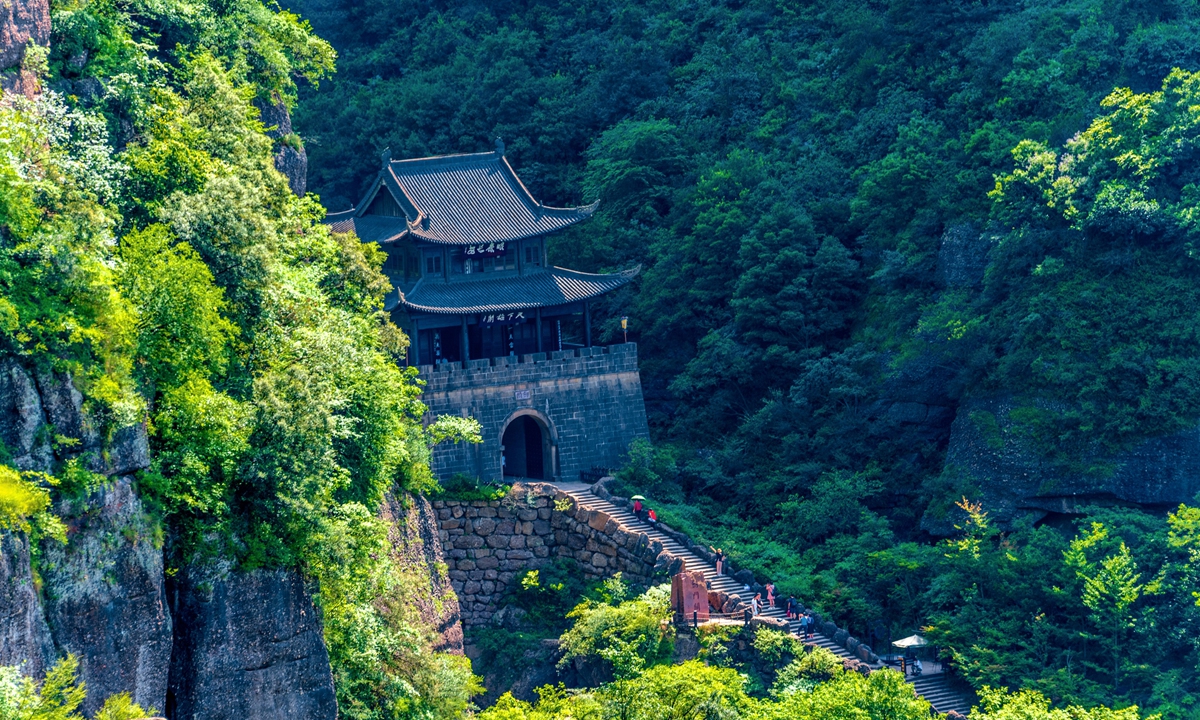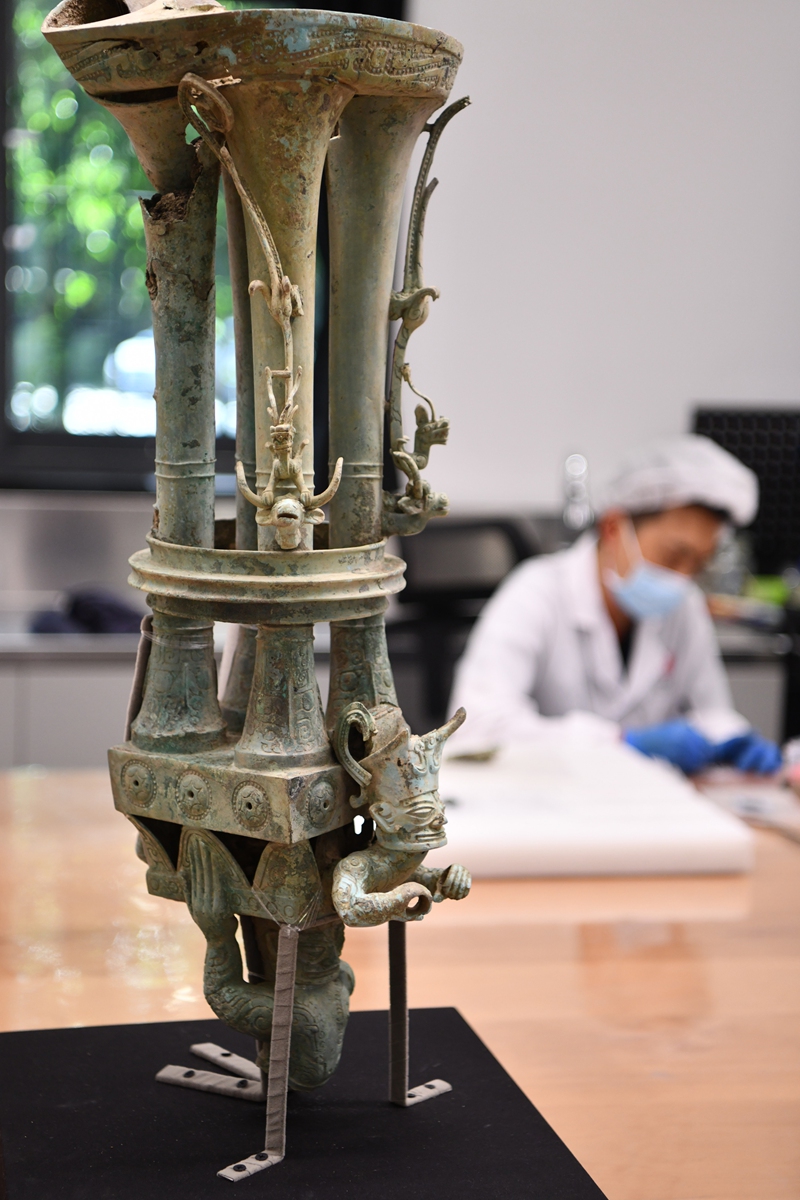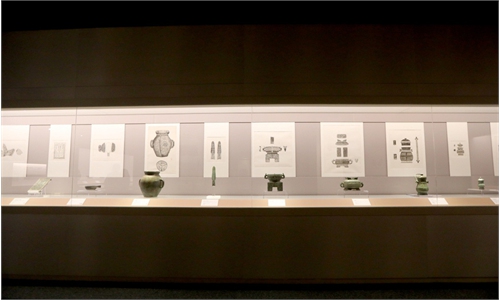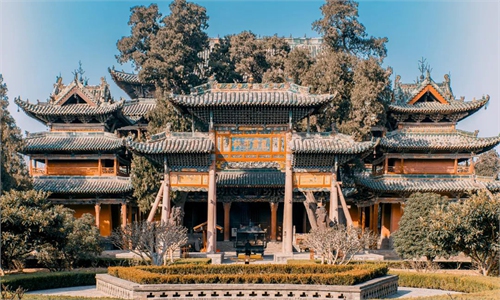ARTS / CULTURE & LEISURE
Xi inspects archaeological achievements in Sichuan, encourages cultural, ecological preservation
Historic inheritance

The Jianmen Pass, an important pass on the ancient Shu Road, in Jiange county, Sichuan Province Photo: IC
Editor's Note:
Chinese President Xi Jinping not only greatly values culture, he has also developed a profound understanding of it.
For him, culture plays a unique and irreplaceable role in the rejuvenation of the Chinese nation and the building of a global community of shared future. He speaks for Chinese wisdom, which has been passed down for millennia, advocates for mutual prosperity of global civilizations, welcomes the flourishing of popular cultural products, and encourages young people to inherit and reinvent their proud traditions.
During a recent inspection in Sichuan Province, a region rich in both culture and nature, Xi highlighted the need for inheriting and developing traditional Chinese culture and building an ecological civilization.

An archaeologist restores cultural relics at the Sanxingdui Museum. Photo: VCG
Chinese President Xi Jinping inspected Southwest China's Sichuan Province on Tuesday and Wednesday, and visited a section of an ancient road system known as "Shudao" in Guangyuan and the Sanxingdui Museum in Deyang.Xi learned about Sichuan's efforts in historical and cultural heritage inheritance, the latest progress in the excavation and research of historical and cultural heritage sites, as well as the protection and restoration of cultural relics.
Chinese experts said that the ancient Shudao, or Shu Road meaning "the road to the Shu kingdom," and Sanxingdui Ruins epitomize China's rich cultural heritage. They are testaments to the resilience, creativity, and inclusiveness of the Chinese nation throughout history.
The preservation and research efforts surrounding these cultural treasures not only contribute to the understanding and appreciation of China's civilization but also serve as sources of inspiration for future generations.
As Xi inspects these cultural heritage sites, the importance of preserving these legacies and enhancing cultural confidence in the Chinese people has been reinforced.
Abundant natural, cultural treasures
The ancient Shu Road, spanning the provinces of Sichuan and Shaanxi, served as a vital transportation route for centuries, connecting the mountains-surrounded Shu region with the Central Plains. The renowned Tang Dynasty poet, Li Bai, vividly depicted the arduous journey along the Shu Road in his famous poem The Difficulty of the Shu Road, illustrating its long and storied history.
Zhang Jun, a guest professor at the History Department of the University of Chinese Academy of Sciences, highlighted the significance of the ancient Shu Road as an important part of the ancient Silk Road. Facilitating cultural exchanges between ancient China and other countries along the Silk Road, it resonates with the Belt and Road Initiative and the Global Civilization Initiative proposed by Xi.
During his visit, Xi explored the Cuiyun Corridor, which has been designated as a national key cultural heritage site, as part of the ancient Shu Road. Cuiyun Corridor features not only the hardship of ancient people's travel in the mountains in order to enter Sichuan, but also the lush greenery of the province as a result of ecological preservation efforts. Spanning over 150 kilometers, it boasts the largest collection of ancient hand-planted cypress trees - a spiritual symbol of the Shu Road. Currently, more than 12,000 ancient cypress trees are preserved along the Cuiyun Corridor, with 7,803 located within Jiange county. Since the Ming Dynasty (1368-1644), local authorities have implemented a system of handing over and replanting ancient cypress trees, which continues to this day.
President Xi has on multiple occasions called for building ecological civilization for sustainable development that features harmonious coexistence between human beings and nature.
The history of the Shu Road also showcases the indomitable spirit of the Chinese people and their unwavering perseverance in the face of hardships, Professor Zhou Xueying from the School of History at Nanjing University said.
Today, these ancient mountain paths are rarely used for travel apart from sightseeing or hiking, as expressways, high-speed rail, and airways have become part of everyday life for locals. From the ancient people who carved cliff-side paths to the dense network of modern transport facilities, the evolution of the ancient Shu Road signifies the resilience imprinted in the Chinese nation's bloodline.
Not far from the Shu Road, on the banks of a river on the Chengdu Plain, a remarkable civilization left its unique mark when Bronze Age winds blew across this ancient land. The Ancient Shu shined brightly, leaving an extraordinary cultural imprint. The Sanxingdui archaeological site from the Ancient Shu is considered one of the greatest discoveries, representing the culture from approximately 4,500 to 2,900 years ago. It was the largest and most culturally rich royal city site in the Yangtze River Basin during that period. Zhang stated that the Sanxingdui culture is a "radiant star" within Chinese culture. Its presence enriches Chinese civilization, adding more mystery to the nation.
Tang Fei, director of the Sichuan Provincial Cultural Relics and Archaeology Research Institute who participated in the visit, told the Global Times that the innovation and inclusiveness of Chinese civilization find vivid representation in Sanxingdui. The open-mindedness of the Ancient Shu people and their absorption of cultural influences from the Central Plains and the middle and lower reaches of the Yangtze River led to the appearance of "imported" artifacts such as jade cong, three-legged pottery, and bronze vessels in Sanxingdui. Moreover, Sanxingdui's uniqueness lies in its distinctive creativity. Based on the assimilation of cultures and technology from outside the region, the ancient people of Sanxingdui created captivating and enigmatic bronze divine trees, monumental human figures, and imposing masks - a remarkable feat when compared to other bronze civilizations around the globe.
Also taking part in the visit, Ran Honglin, head of the archaeological team at the Sanxingdui Ruins, told the Global Times that many bronzes and jades related to sacrificial activities at Sanxingdui are unique in China and even the world.

A road on the cliff at the Jianmen Pass, part of the Shu Road in Sichuan Province Photo: VCG
Confidence from inheritanceIt's not the first time President Xi has called for carrying forward and learning from fine traditional Chinese culture in Sichuan.
Xi once emphasized that the Chinese people should respect fine traditional Chinese culture and build up cultural confidence while visiting San Su Ci, the memorial temple and former residence of Su Xun and his two sons Su Shi and Su Zhe, three literary masters of the Northern Song Dynasty (960-1127), to learn about local efforts in protecting historical and cultural heritage, in Meishan, Sichuan Province, on June 8, 2022.
Chinese culture has a long and continuous history while Chinese civilization is extensive and profound. A profound understanding of the history of Chinese civilization is essential to promoting the creative transformation and innovative development of fine traditional Chinese culture in a more effective manner, pushing more strongly ahead with the building of a cultural sector with Chinese characteristics and developing a modern Chinese civilization, Xi said in a meeting on cultural inheritance and development on June 2.
President Xi also called for attaching greater importance to archaeological research to deepen people's understanding of Chinese civilization that features a long history and profoundness, thus providing strong support for promoting fine traditional culture and strengthening people's confidence in Chinese culture.
Learning more about China's profound cultural heritage is inseparable from one particular important project - the National Project to Trace the Origins of Chinese Civilization.
Tracing the origins of civilization is an extremely important subject in the study of human history. How long ago did Chinese civilization begin? How did this civilization form and develop? What factors and internal mechanisms impacted this formation and development? China's national origin's project aims to answer the above questions, Wang Wei, director of the Chinese Academy of Social Sciences' Academic Division of History, told the Global Times after attending a traditional culture-themed meeting with Xi.
Wang has worked on the national project for decades. He explained that the project, initiated in 2002, is the largest interdisciplinary endeavor dedicated to unraveling the origins and early development of Chinese civilization over a span of over 5,000 years.
Over the past two decades, more than 400 experts and scholars from over 20 disciplines and numerous institutions have conducted extensive excavations at four urban sites dating back to 3500BC to 1500BC, as well as large-scale archaeological surveys of settlements in the Yellow, Yangtze, and Liao river basins. With the expansion of the project, sites such as Liangzhu, Shimao, Taosi, and Erlitou have unequivocally demonstrated that the Chinese people entered the realm of civilization over 5,000 years ago.
The global archaeological community has long regarded "metallurgy, writing, and cities" as the three key elements of civilization. In May 2018, a team of Chinese experts on the project announced China's criteria for the elements of civilization: the development of production, population growth and the emergence of cities; social division of labor, class differentiation, and the appearance of classes; the establishment of a monarchy and state systems.
Based on these standards, the project has achieved fruitful results. For example, 5,500 years ago in regions such as the middle and lower reaches of the Yellow, Yangtze, and Liao rivers, close interactions formed among the upper echelons of society, leading to the worship of the Chinese dragon, the appreciation of jade, and a system of ceremonial objects that symbolize the elevated status of their owners.
Rowan K. Flad, a John E. Hudson professor of archaeology in the Department of Anthropology, Harvard University, told the Global Times that China's national origins project is "very high quality work."
Flad noted that the most important contributions that come from scholarly projects such as the national origins project is new data, made widely available, that illustrate the variety and complexity of the ancient life of people in China at different points in time.
Furthermore, Chinese civilization is the only uninterrupted ancient civilization in the world. Research and interpretation of its origins, development, and other aspects not only hold global significance but also can help countries worldwide to better inherit the best of traditional Chinese culture.





